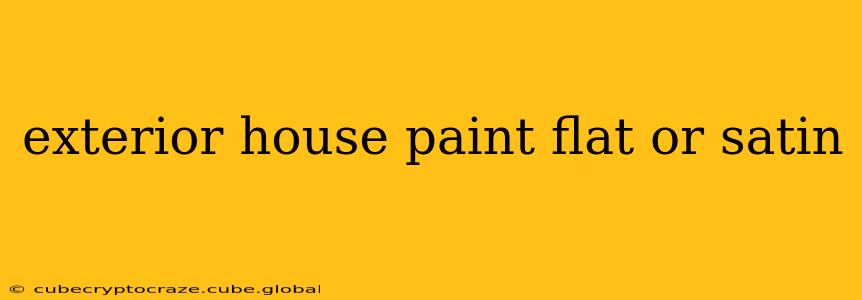Choosing the right exterior house paint can significantly impact your home's curb appeal and longevity. One of the most important decisions is selecting the sheen: flat or satin. Both offer distinct advantages and disadvantages, making the choice dependent on your specific needs and priorities. This comprehensive guide will help you navigate the decision-making process and choose the perfect finish for your home.
What is the Difference Between Flat and Satin Exterior Paint?
The key difference lies in the amount of light reflection. Flat paint, also known as matte paint, has almost no sheen. It absorbs light, minimizing imperfections on the surface. Satin paint possesses a subtle, low-luster sheen. It reflects more light than flat paint, giving it a slightly smoother, more polished appearance.
What are the Pros and Cons of Flat Exterior Paint?
Pros of Flat Exterior Paint:
- Excellent at hiding imperfections: The lack of sheen makes it ideal for covering minor surface flaws like small cracks or texture variations.
- Provides a classic, sophisticated look: Its matte finish offers a timeless aesthetic that many homeowners appreciate.
- Often more affordable: Flat paint is generally less expensive than satin paint.
Cons of Flat Exterior Paint:
- More difficult to clean: Its porous surface makes it challenging to clean, as dirt and grime can easily penetrate and stain the paint.
- Less durable: It's less resistant to scrubbing and wear and tear, making it less suitable for high-traffic areas or surfaces prone to damage.
- Not as mildew resistant: Flat paint tends to be more susceptible to mildew growth, particularly in humid climates.
What are the Pros and Cons of Satin Exterior Paint?
Pros of Satin Exterior Paint:
- Easier to clean: Its slightly glossy surface is more resistant to dirt and grime, making it easier to wipe clean.
- More durable and scrubbable: Satin paint offers better protection against scratches and scuffs, extending its lifespan.
- Better mildew resistance: The smoother surface and slightly higher sheen deter mildew growth.
- Enhances color vibrancy: The subtle sheen makes the colors appear richer and more vibrant.
Cons of Satin Exterior Paint:
- May highlight surface imperfections: The slight sheen can accentuate minor flaws, requiring more surface preparation before painting.
- Can be more expensive: Satin paint generally costs more than flat paint.
Which Sheen is Best for Different Exterior Surfaces?
The ideal sheen can vary depending on the surface you're painting:
- Trim and Doors: Satin is often preferred for trim and doors due to its durability and ease of cleaning. The higher scrubbability is essential for areas that are frequently touched or exposed to the elements.
- Walls: Either flat or satin can be used, but the choice often depends on the level of imperfection and desired maintenance. If imperfections are minimal, satin offers better cleaning capabilities.
- Brick: Satin can be a good choice for brick as it helps to protect against moisture damage.
- Stucco: Flat paint may work better for stucco to hide minor imperfections, while satin provides better cleanability.
How Long Does Each Type of Exterior Paint Last?
Both flat and satin exterior paints are designed to withstand outdoor conditions, but their longevity can vary based on factors like climate, quality of paint, and surface preparation. Generally, high-quality paints of either sheen can last for 5-10 years or more with proper preparation and maintenance.
Is Flat Exterior Paint Suitable for High-Traffic Areas?
No, flat exterior paint is generally not recommended for high-traffic areas. Its porous nature makes it more susceptible to damage and harder to clean. Satin paint is a better choice for areas that experience frequent contact or are prone to scuffs and scratches.
Does Satin Exterior Paint Show Imperfections More Than Flat Paint?
Yes, satin exterior paint can highlight surface imperfections more than flat paint due to its slight sheen. Thorough surface preparation is essential before applying satin paint to minimize the visibility of any flaws.
Which Type of Exterior Paint is More Resistant to Mildew?
Satin exterior paint is generally more resistant to mildew than flat paint due to its less porous surface and the ability to repel moisture better. However, proper surface preparation and regular cleaning are crucial for preventing mildew growth regardless of the sheen.
By carefully considering these factors and weighing the pros and cons of flat and satin exterior paints, you can make an informed decision that best suits your home's needs and your personal preferences. Remember to always follow the manufacturer's instructions for application and maintenance.
